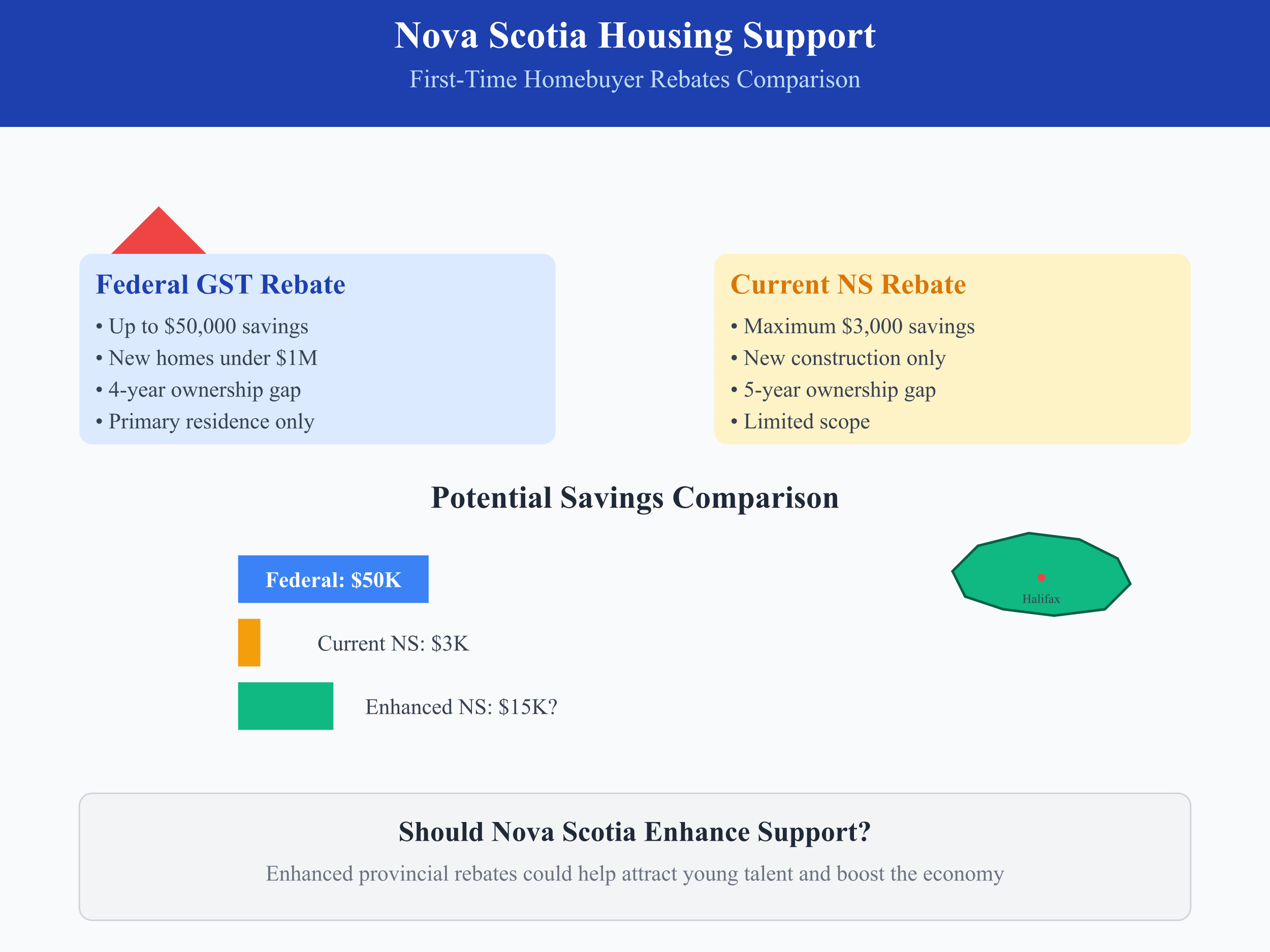Is It Time for Nova Scotia to Boost First-Time Homebuyer Support?
With federal tax relief on the way, the Maritime province faces a pivotal decision about housing affordability
Walking through Halifax neighborhoods today, you’ll see plenty of “For Sale” signs—but fewer and fewer young families moving in. The reality is stark: homeownership has become a distant dream for many Nova Scotians who grew up expecting it as a natural milestone.
Sarah Chen, a 28-year-old software developer in Halifax, captures the frustration many feel. “I make decent money, but between rent, student loans, and trying to save for a down payment, it feels impossible. My parents bought their first house at my age with way less stress.”
Sarah’s story isn’t unique. Across Nova Scotia, young professionals, teachers, healthcare workers, and tradespeople find themselves priced out of markets their parents entered with relative ease. But recent federal announcements have reignited hope—and raised questions about whether provincial governments will rise to meet the moment.
Federal Relief Finally Arrives
Ottawa’s newest initiative represents the most significant federal housing support in years. Starting soon, first-time homebuyers won’t pay GST on newly constructed homes under $1 million—a potential savings of up to $50,000. For homes priced between $1 million and $1.5 million, buyers receive partial rebates through a graduated system.
The program targets exactly the demographic struggling most: young Canadians who haven’t owned homes in at least four years and plan to live in their purchase as a primary residence. Whether buying from a builder, constructing a custom home, or purchasing co-op housing, eligible buyers can access these substantial savings.
For perspective, a couple buying a $350,000 new townhouse in Dartmouth would save $17,500—enough to cover their moving costs, appliances, and still have money left for mortgage payments or emergency savings.
Nova Scotia’s Current Approach: Modest but Limited
The province hasn’t completely ignored first-time buyers. Nova Scotia’s existing rebate returns 18.75% of the provincial HST portion on new home purchases, capped at $3,000. While helpful, this modest support feels inadequate given today’s housing costs.
The provincial program also includes restrictions that limit its usefulness. Buyers must wait five years since their last home ownership—longer than federal requirements—and only new construction qualifies. No help exists for buyers interested in existing homes in established neighborhoods.
Beyond this single rebate, Nova Scotia offers various incentives for developers and investors, plus energy efficiency programs. However, none specifically address the financial barriers preventing young Nova Scotians from transitioning from renting to owning.
The Case for Stepping Up
Young Talent is Mobile
Nova Scotia competes nationally for young professionals, particularly in growing sectors like technology, healthcare, and renewable energy. When talented individuals compare opportunities across provinces, housing affordability plays a significant role in their decisions.
Consider two job offers: one in Halifax and another in a city where robust homebuyer support makes property ownership achievable within a few years. Many young professionals will choose the location where they can build equity and establish roots, rather than remain perpetual renters.
Economic Multiplier Effects
First-time homebuyers don’t just purchase properties—they fuel economic activity across multiple sectors. They hire movers, buy furniture, renovate kitchens, landscape yards, and invest in their communities in ways that renters typically don’t.
This spending creates jobs for contractors, retail workers, landscapers, and countless service providers. The tax revenue generated through property taxes, sales taxes, and income taxes from this economic activity often exceeds the initial cost of rebate programs.
Community Stability
Homeownership creates deeper community connections. Homeowners participate more actively in local organizations, advocate for neighborhood improvements, and provide the stability that makes communities attractive to businesses and additional residents.
When young families can afford to buy homes, they’re more likely to stay long-term, send their children to local schools, and contribute to the social fabric that makes communities thrive.
Learning from British Columbia’s Success
British Columbia faces some of Canada’s most challenging housing markets, yet maintains comprehensive support programs that help first-time buyers succeed. BC’s approach combines generous rebates with innovative financing options and targeted assistance for different buyer segments.
The province recognizes that supporting homeownership isn’t just social policy—it’s economic development strategy. By helping residents transition from renters to owners, BC strengthens its tax base, retains talent, and builds more stable communities.
Nova Scotia could adopt similar comprehensive approaches, potentially including:
- Increased rebate amounts that make a meaningful difference
- Expanded eligibility to include existing homes
- Down payment assistance programs
- Shared equity loans for qualifying buyers
The Counterarguments
Fiscal Constraints
Provincial budgets face enormous pressure. Healthcare systems need investment, schools require upgrades, and infrastructure demands attention. Every dollar spent on housing rebates represents resources unavailable for other critical services.
Policymakers must balance the potential benefits of enhanced homebuyer support against other pressing needs. In tight fiscal environments, these choices become particularly difficult.
Market Effects
Increased buyer incentives could potentially drive up home prices if housing supply doesn’t expand correspondingly. If rebate programs increase demand without addressing supply constraints, the benefits might flow to sellers rather than buyers.
There’s also risk of creating artificial market conditions that become difficult to maintain long-term, potentially setting up future buyers for disappointment if programs end.
Federal Support Might Suffice
The new federal rebate represents substantial improvement over current conditions. For many potential buyers, saving $15,000 to $50,000 might provide exactly the boost needed to make homeownership feasible without additional provincial intervention.
A Strategic Moment
The federal announcement creates a unique opportunity for provinces to amplify support without bearing full program costs alone. By layering provincial incentives with federal ones, Nova Scotia could create compelling conditions for first-time buyers while demonstrating commitment to housing affordability.
This moment feels particularly strategic given Nova Scotia’s economic trajectory. Halifax’s growing reputation as an Atlantic Canadian business hub, combined with increasing remote work flexibility, positions the province to attract talent from across Canada and beyond.
Enhanced homebuyer support could become a competitive advantage in talent recruitment, helping Nova Scotia capitalize on these broader economic trends.
Beyond Individual Benefits
Supporting first-time homebuyers creates ripple effects that extend far beyond individual families. When young professionals can afford homes, they’re more likely to start families, invest in local businesses, and contribute to the tax base that funds public services.
These buyers often purchase starter homes from existing owners who then move up to larger properties, creating a healthy real estate cycle that benefits buyers and sellers across all price ranges.
The alternative—continued rental housing dependence among young professionals—limits wealth building opportunities and reduces the stability that comes with homeownership.
The Path Forward
Nova Scotia stands at a crossroads. The province can maintain its current modest approach and hope federal support proves sufficient, or it can seize this moment to enhance its competitiveness and support the next generation of homeowners.
The decision will influence not just individual families but the province’s broader economic development trajectory. In an era when young talent has unprecedented mobility, provinces that create pathways to homeownership will have significant advantages in building vibrant, growing communities.
For thousands of Nova Scotians currently saving for down payments while watching home prices rise, these policy decisions could determine whether homeownership remains an achievable goal or becomes an impossible dream.
The federal government has provided the foundation. Now it’s up to provinces like Nova Scotia to decide whether they’ll build on that foundation to create truly transformative support for first-time homebuyers.
This analysis is provided for informational purposes and should not be considered financial or legal advice. Prospective homebuyers should consult qualified professionals to understand how current and proposed programs might apply to their specific situations.

 Facebook
Facebook
 X
X
 Pinterest
Pinterest
 Copy Link
Copy Link

